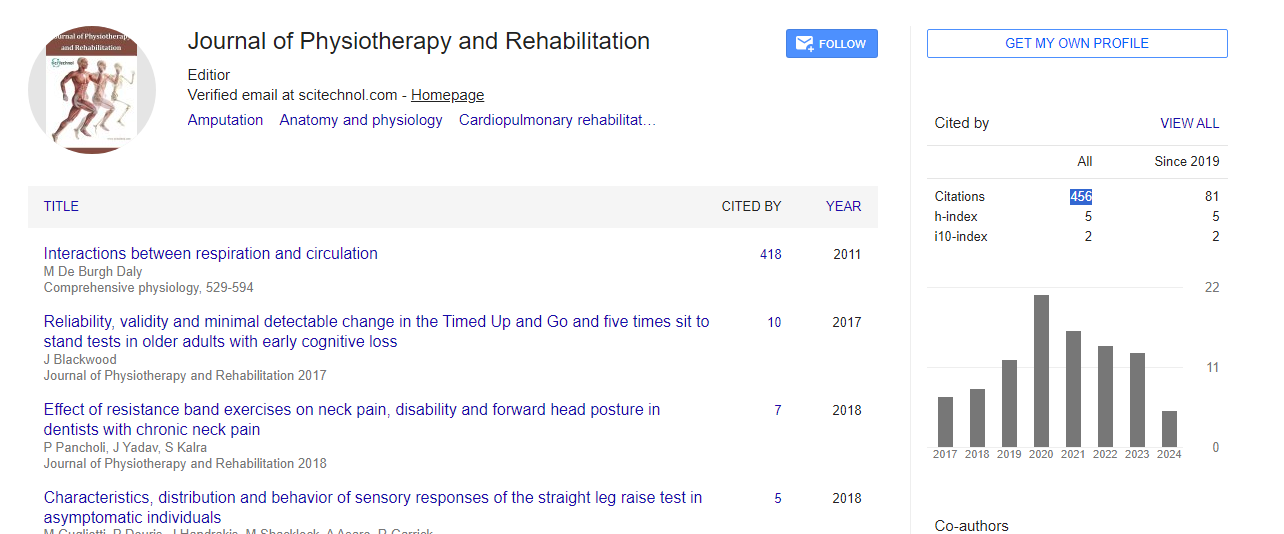Commentary, J Physiother Rehabi Vol: 8 Issue: 5
Impact of Geriatric Physical Therapy on Functional Independence in the Aging Population
Noah Patel*
1Department of Physical Therapy, San Jorge University, Zaragoza, Spain
*Corresponding Author: Noah Patel,
Department of Physical Therapy, San Jorge
University, Zaragoza, Spain
E-mail:noah_patel@domain.es
Received date: 24 September, 2024, Manuscript No. JPTR-24-151642
Editor assigned date: 26 September, 2024, PreQC No. JPTR-24-151642 (PQ);
Reviewed date: 10 October, 2024, QC No. JPTR-24-151642
Revised date: 17 October, 2024, Manuscript No. JPTR-24-151642 (R);
Published date: 24 October, 2024, DOI: 10.4172/JPTR.1000186.
Citation: Patel N (2024) Impact of Geriatric Physical Therapy on Functional Independence in the Aging Population. J Physiother Rehabi 8:5.
Description
The impact of geriatric physical therapy on functional independence in the aging population is both extreme and essential. As people age, the risk of physical and cognitive decline increases, making daily activities more challenging and reducing their quality of life. Functional independence, the ability to perform day-to-day activities without external assistance, is often compromised in older adults due to factors like muscle weakness, joint degeneration and balance problems. Geriatric physical therapy plays an important role in addressing these issues, empowering older adults to maintain or regain independence, mobility and overall well-being.
Physical therapy programs designed for the elderly focus on strength training exercises, which help counteract muscle loss and improve functional capabilities. By enhancing muscular strength, older adults can perform routine activities such as bathing, dressing and cooking with greater ease and confidence. Balance and coordination, critical aspects of functional independence, also tend to deteriorate with age, resulting in a higher risk of falls. Falls are a leading cause of injury and hospitalization among older adults and can lead to health complications. Physical therapy interventions aimed at balance training, such as exercises on unstable surfaces, coordination drills and flexibility exercises, can significantly reduce fall risk. With improved balance, elderly individuals are more likely to avoid falls and feel confident in moving around their homes and communities.
Mobility is another critical area where geriatric physical therapy makes a substantial difference. Conditions like osteoarthritis, hip fractures and stroke often impair mobility in older adults, making it difficult to walk, climb stairs, or maintain an active lifestyle. Physical therapy helps to improve gait and mobility through a combination of stretching, strengthening and endurance exercises. Assistive devices, such as walkers or canes, may also be incorporated into therapy to further enhance mobility and independence. With regular therapy, older adults often experience improved walking speed and stability, which in turn increases their ability to participate in social activities, reducing feelings of isolation and depression that frequently accompany physical limitations. The therapeutic process itself, involving goal setting and progression tracking, provides a sense of accomplishment and purpose. Physical therapists often encourage and motivate patients, encourage a positive environment that can reduce anxiety and depression associated with aging and physical decline. These conditions can severely limit functional independence, but physical therapists use targeted interventions to alleviate symptoms and prevent further deterioration. For instance, in patients with arthritis, physical therapists teach joint protection techniques and exercises that reduce pain and improve joint mobility, while stroke patients benefit from therapies that focus on restoring strength and coordination in affected limbs. Such personalized care not only enhances physical function but also allows for a better quality of life.
Conclusion
Geriatric physical therapy is a vital intervention for preserving and restoring functional independence in the aging population. By addressing physical limitations such as muscle weakness, balance issues and mobility impairments, it allows older adults to maintain a sense of autonomy and dignity. Beyond physical improvements, the psychological benefits of increased independence contribute to a higher quality of life, the importance of geriatric physical therapy as an integral component of healthcare for the elderly.
 Spanish
Spanish  Chinese
Chinese  Russian
Russian  German
German  French
French  Japanese
Japanese  Portuguese
Portuguese  Hindi
Hindi 